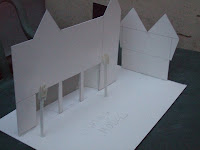For my experimentation with making models for lighting reference I have chosen to create artwork of the same scene, lit in various different ways, to see how it effects the way the composition is read. I began by choosing the composition from my Major Project that I wanted to use as a subject for my experimentation (pictured below). I chose this composition as I wanted to experiment with the way natural light casts shadows and it is an outdoor scene, enabling me to do that. It also has elements that could cast large shadows, drastically altering the composition depending on the directional lighting.
After choosing the composition that I wanted to use, I then constructed a rough 3-dimensional model of the main forms that would cast shadow within the composition.
I constructed the model using card, off-cuts of board, paper straws and hot-glue. I then took my model outside, photographing it in different lighting conditions and angled at different positions in relation to the sun, to cast shadows in different directions.





This exercise has been really helpful in showing me the way in which shadows are softer in overcast and twilight conditions and how drastically the lighting can affect the look of a scene. The next stage of my investigation is to make black and white thumbnails of the most effective lighting schemes to look more closely at how the lighting affects the reading of scenery.





